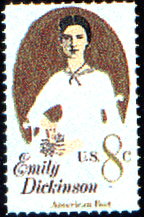Emily Dickinson
 Emily Dickinson is, in a sense, a link between her era and the
literary sensitivities of the turn of the century. A radical
individualist, she was born and spent her life in Amherst,
Massachusetts, a small Calvinist village. She never married, and
she led an unconventional life that was outwardly uneventful but
was full of inner intensity. She loved nature and found deep
inspiration in the birds, animals, plants, and changing seasons
of the New England countryside.
Emily Dickinson is, in a sense, a link between her era and the
literary sensitivities of the turn of the century. A radical
individualist, she was born and spent her life in Amherst,
Massachusetts, a small Calvinist village. She never married, and
she led an unconventional life that was outwardly uneventful but
was full of inner intensity. She loved nature and found deep
inspiration in the birds, animals, plants, and changing seasons
of the New England countryside.
Dickinson spent the latter part of her life as a recluse, due to an extremely sensitive psyche and possibly to make time for writing (for stretches of time she wrote about one poem a day). Her day also included homemaking for her attorney father, a prominent figure in Amherst who became a member of Congress.
Dickinson was not widely read, but knew the Bible, the works of William Shakespeare, and works of classical mythology in great depth. These were her true teachers, for Dickinson was certainly the most solitary literary figure of her time. That this shy, withdrawn, village woman, almost unpublished and unknown, created some of the greatest American poetry of the 19th century has fascinated the public since the 1950s, when her poetry was rediscovered.
Dickinson's terse, frequently imagistic style is even more modern and innovative than Whitman's. She never uses two words when one will do, and combines concrete things with abstract ideas in an almost proverbial, compressed style. Her best poems have no fat; many mock current sentimentality, and some are even heretical. She sometimes shows a terrifying existential awareness. Like Poe, she explores the dark and hidden part of the mind, dramatizing death and the grave. Yet she also celebrated simple objects -- a flower, a bee. Her poetry exhibits great intelligence and often evokes the agonizing paradox of the limits of the human consciousness trapped in time. She had an excellent sense of humor, and her range of subjects and treatment is amazingly wide. Her poems are generally known by the numbers assigned them in Thomas H. Johnson's standard edition of 1955. They bristle with odd capitalizations and dashes.
A nonconformist, like Thoreau she often reversed meanings of words and phrases and used paradox to great effect. From 435:
To a discerning Eye --
Much Sense -- the starkest Madness --
'Tis the Majority
In this, as All, prevail --
Assent -- and you are sane --
Demur -- you're straightway dangerous
And handled with a chain --
Her wit shines in the following poem (288), which ridicules ambition and public life:
How dreary -- to be -- Somebody!
Are you -- Nobody -- Too?
Then there's a pair of us?
Don't tell! they'd advertise -- you
know!
How public -- like a Frog --
To tell one's name -- the livelong
June --
To an admiring Bog!
Dickinson's 1,775 poems continue to intrigue critics, who often disagree about them. Some stress her mystical side, some her sensitivity to nature; many note her odd, exotic appeal. One modern critic, R.P. Blackmur, comments that Dickinson's poetry sometimes feels as if "a cat came at us speaking English." Her clean, clear, chiseled poems are some of the most fascinating and challenging in American literature.
